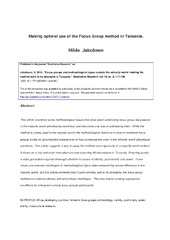| dc.contributor.author | Jakobsen, Hilde | |
| dc.date.accessioned | 2014-07-01T14:00:46Z | |
| dc.date.available | 2014-07-01T14:00:46Z | |
| dc.date.issued | 2012-04 | eng |
| dc.identifier.issn | 1468-7941 | |
| dc.identifier.uri | https://hdl.handle.net/1956/8043 | |
| dc.description.abstract | This article examines some methodological issues that arise when conducting focus group discussions in the majority world (developing countries), and describes one way of addressing them. While the method is widely used in the majority world, the methodological literature on how to moderate focus groups builds on accumulated experiences of how conversations work in the minority world (developed countries). This article suggests a way to apply the method more rigorously in a majority-world context. It draws on a trial-and-error innovation process spanning 40 discussions in Tanzania. Ensuring quality in data generation required thorough attention to issues of alterity, positionality and power. These issues are common challenges to methodological rigour when researching across difference in the majority world. But this article contends that if used correctly and to its strengths, the focus group method can indeed address and solve these challenges. This also entails creating appropriate conditions for interaction among focus groups participants. | en_US |
| dc.language.iso | eng | eng |
| dc.publisher | SAGE | eng |
| dc.relation.ispartof | <a href="http://hdl.handle.net/1956/10118" target="blank">The Good Beating: Social norms supporting men’s partner violence in Tanzania</a> | eng |
| dc.subject | Focus Group Discussions | eng |
| dc.subject | Qualitative methods | eng |
| dc.subject | Qualitative methodology | eng |
| dc.subject | Development Studies | eng |
| dc.subject | Africa | eng |
| dc.subject | Tanzania | eng |
| dc.subject | Positionality | eng |
| dc.subject | Reflexivity | eng |
| dc.subject | Data quality | eng |
| dc.subject | Qualitative research | eng |
| dc.subject | Fieldwork | eng |
| dc.title | Making optimal use of the Focus Group method in Tanzania | eng |
| dc.type | Peer reviewed | |
| dc.type | Journal article | |
| dc.description.version | acceptedVersion | |
| dc.rights.holder | Copyright 2012 by The Author | |
| dc.identifier.doi | https://doi.org/10.1177/1468794111416145 | |
| dc.identifier.cristin | 951684 | |
| dc.source.journal | Qualitative Research | |
| dc.source.40 | 12 | |
| dc.source.14 | 2 | |
| dc.source.pagenumber | 111-130 | |
